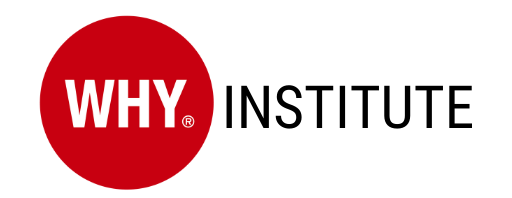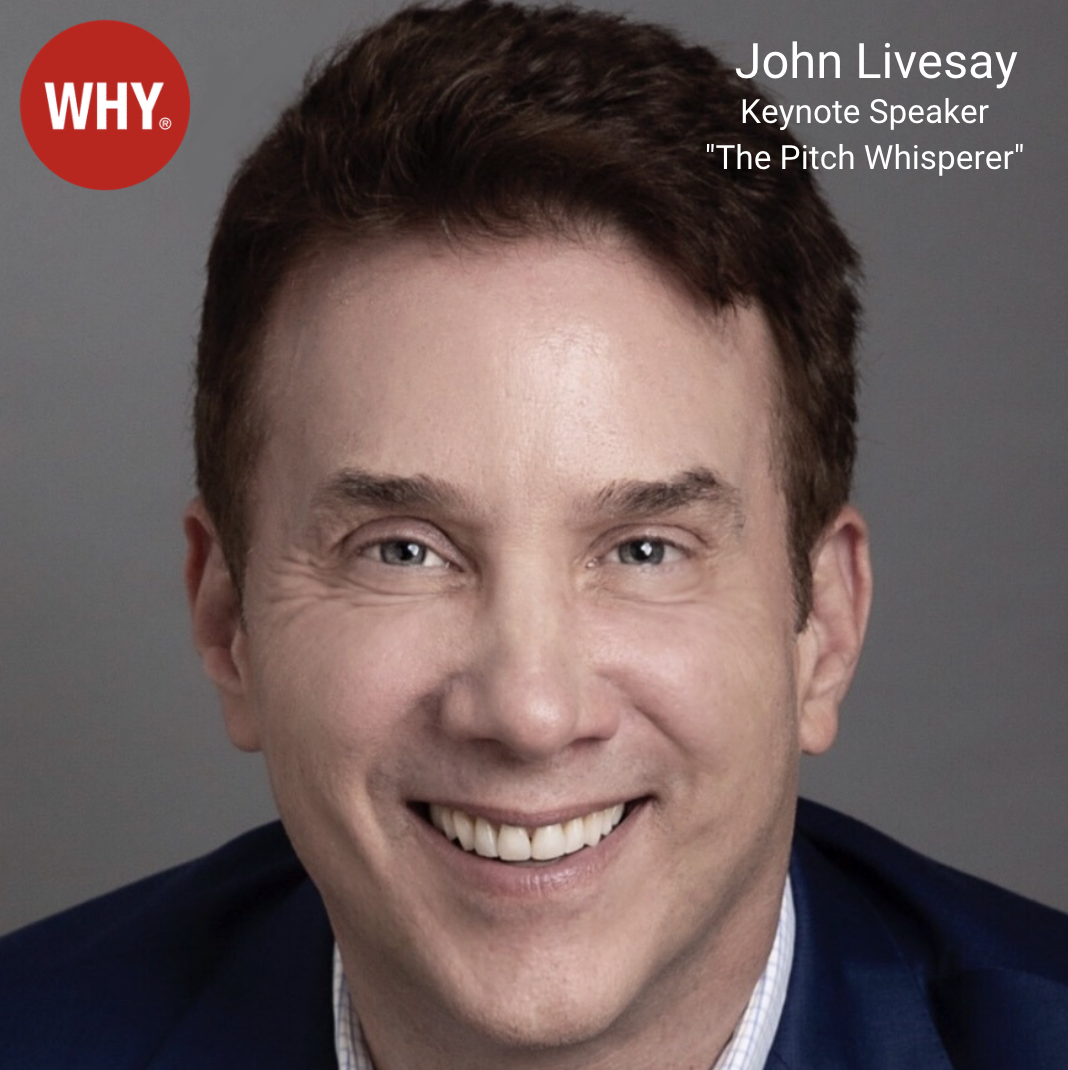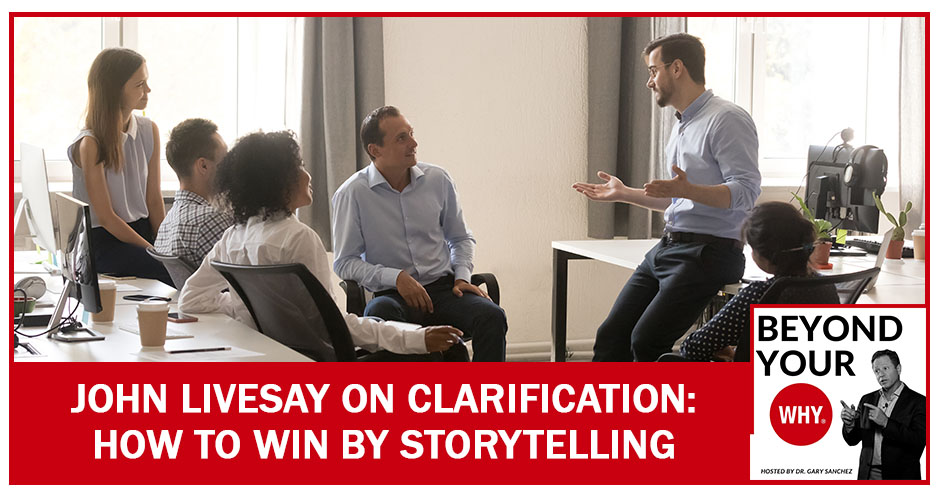
For WHY on Clarify, it’s important for people to “get” what you’re saying. If clarification is your WHY, you’ll love to win by storytelling. Dr. Gary Sanchez welcomes John Livesay, aka “The Pitch Whisperer.” John is a sales keynote speaker, showing companies’ sales teams how to win more business using stories. A great story should be clear, concise, and compelling. The goal is to make it exciting enough that your readers don’t want to put it down. If you want to know more about effective storytelling, tune in!
—
Watch the episode here
Listen to the podcast here
John Livesay On Clarification: How To Win By Storytelling
We’re going to be talking about the why of clarify, to clarify or make crystal clear. If this is your why, then you seek to be fully understood at all times. Everything has to be crystal clear. It is important for you to know that people get what you’re saying, and you will use numerous methods to get a point across and make sure it’s clear.
You will use analogies and metaphors to share your views in an interesting and unique manner. You feel successful when you know that, with confidence, your message has been fully understood and received. You want to reach this place of clarity and understanding before decisions are made, and people move forward with a plan of action.
I’ve got a great guest for you. I have had him on before, but a lot has changed since then. I wanted to have him on again. His name is John Livesay, also known as, The Pitch Whisper. He is a sales keynote speaker where he shows companies’ sales teams how to turn mundane case studies into compelling case stories so they win more new business.
From John’s award-winning career at Conde Nast, he shares the lessons he learned that turned sales teams into revenue rockstars. His TEDx Talk, Be The Lifeguard of Your Own Life!, has over 1 million views. His new book, The Sale Is in the Tale, is a business fable set in Austin, Texas. It’s about a sales representative whose old ways of selling are not working anymore.
The reader accompanies that rep on his journey and learns how to use storytelling and strengthen their soft skills to improve their professional and personal relationships. He is also the host of The Successful Pitch Podcast, which is heard in over 60 countries. These interviews make him a sales keynote speaker with fresh and relevant content. John, welcome to the show.
Thanks for having me back, Gary.
It’s going to be fun. What I want to do is let’s jump into your book. I want to hear about your book because it’s a fable. I also have a big interest in how you wrote a fable. Let’s talk about the fable and then let’s talk about how you wrote the fable.
It’s a story about storytelling and I have been impressed with a lot of other fables in the past all the way back to Who Moved My Cheese?, to The Go Giver and Getting Naked, but no one’s written a fable from the perspective of a salesperson being the hero or the main character. I thought, “It would be very entertaining hopefully to say what that feels like to be in those situations.”
I looked and fictionalized some of the things that had happened to me in my career and some of the things I wished had happened to me, like meeting people that could help me and learn how to be better storytellers sooner. That process was quite fascinating and surprisingly fun because instead of telling people, I wanted to show them in the story and they’re learning while they’re engaged in the story. As with any good story, if you care about the characters, you can’t wait to see what happens next. A little bit of drama and suspense, making that all come to life with them at the end having their methodologies available to use what you learned was the whole intent.
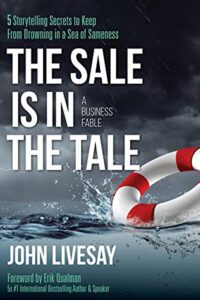
Take us into the story without telling us too much. Who’s the main character? What’s going on with them and what happens here?
The guy’s name is Ben. He’s in his early 30s, working at a medical tech sales company here in Austin, where I live. I sprinkled in some real-life locations. He’s hit a sales slump. He doesn’t get the promotion he was supposed to get because he lost a big sale. He doesn’t know why the old way of selling of memorizing a bunch of facts and figures is no longer working.
He gets a mentor in the form of a coworker who is a tech expert, who watches a lot of sales presentations, and she sees that the people who are winning are the ones that are telling stories. He’s a little skeptical at first. He then starts to try it out. Anything you try out, you don’t become an expert at whether it’s riding a bike, you need the training wheels on it at first, or driving a stick shift for the first time, it’s a little jerky.
We go through some of those bumps along the way, and then he starts to get more traction. There are some nice outcomes at the end that he has some choices that he didn’t have. He goes from feeling like, “I could get fired. I didn’t go to get promoted,” to, “I’ve got places wanting me inside and outside the company,” all through becoming more comfortable with storytelling.
Was that your story?
In a way, yes. I fictionalized some of it. There’s a situation in the first chapter or opening of any story that is going to grab you. It’s being on a plane with a boss who doesn’t like you, and everything that could possibly go wrong on a sales call, and then having to be on that plane ride back with the boss who didn’t like you to begin with. That part happened to me. It’s fictionalized. If you’ve been in business at all, you all had a boss that you didn’t get along with at some point in your career. Some of that definitely is true.
For the people that have not read the first time I had you on, tell them a little bit more about you, your story, how you got into storytelling, why it became important to you, why you switched directions in your career to be about storytelling and teach others to do this.
I first started my career selling multimillion-dollar mainframe computers in the tech industry. That was competing against IBM. It was all I thought were going to be numbers that were so logical people would buy based on speeds and things. It turns out it was an emotional buy that people had said, “Your equipment might be faster, even less expensive, and more reliable, but we’re still not going to buy it because if it breaks, IBM is going to point the finger at you,” and say, “It’s our fault for bringing you in, and we’ll get fired.”
Back then, it broke a lot. It was fear, uncertainty, and doubt that they were using to keep people from leaving. I thought, “There’s a lot of emotion to this sale process like in advertising,” which I majored in that I hadn’t thought was going to appeal in this level. I went and worked for an ad agency in Los Angeles, creating commercials for movies coming out on home video.
[bctt tweet=”The people who are winning are the ones that are telling stories. ” username=”whyinstitute”]
I learned we could reposition the movie if it hadn’t done well theatrically and have it edited in a different way that made people want to rent it. That’s where I honed my storytelling skills. The third career I had was selling media or advertising for publications. Lexus would say, “We looked at 50 magazines. We’ve narrowed it down to 10. You’re each coming in for 30 minutes. Don’t talk about numbers. We’ve already analyzed that. We’re going to pick three.”
Some of the reps were like a deer in headlights. They’re like, “Don’t talk about numbers.” “What I don’t know if it’s regulation or the income of my readers, what I’m going to talk about?” I realized from my advertising agency background, whoever tells the best story of what the marketing idea is going to be is what’s going to win this sale. That led to a long fifteen-year career with some bumps along the way. I got laid off in 2008.
I had to reinvent myself. I learned how to sell digital, then got rehired back, won salesperson of the year, and that became the premise of the TED Talk of we all have to learn to be the lifeguard over our own life. No one’s going to come and rescue us like in a hurricane when you don’t evacuate. Now, I have a passion for helping people tell stories because it makes you feel much less pushy, and you become memorable. Whoever tells the best story, no matter what you’re selling, is the one that gets the sale.
What makes up a great story?
A great story should be three things. It should be clear, concise, and compelling. Let’s look at each one of those. If it’s not clear and you use a bunch of acronyms and confuse people, they’re never going to say they’re confused. They’re going to say, “No thanks.” Concise. Here’s the secret of why it needs to be concise. It’s so that someone can remember it. The meeting after the meeting that nobody ever thinks about.
If you put your empathy hat on of the buyers, they hear three different pitches from three different people. They then have a meeting after the meeting, and they go, “What do you all think?” “They all sound the same. We should buy the cheapest.” If you’re the one that told a story as concise enough for them to remember and retell, they become your brand ambassador. Finally, compelling. We buy emotionally, not logically. When you use words like struggle or overwhelmed to describe the pain point of someone, they feel something. When you tug at heartstrings, people open the purse strings.
Would you have an example of that, that we can feel?
I was working with a healthcare medical company. They were selling 4k resolution monitors for the doctors to use in a hospital. I’m talking about pixels and all the features of it. They tell this story. Dr. Peterson at a rural hospital in Minnesota, not known for cutting edge technology, decided to test this resolution monitor. Blake, the salesperson, was in the operating room in case there were any questions. In this particular surgery, the patient was overweight, which caused the surgery to be a little riskier, and because of that, the doctor hit a bleeder.
There was an audible gasp in the operating room because, to the naked eye, it was a sea of red. The doctor calmly looked up at the resolution monitor, and the subtle colors in red between oxygenated blood and non-oxygenated blood allowed him to find the source of the bleeder quickly and save the patient’s life. Turn to the rep and said, “We don’t always need a monitor like this, but when we need one, we need one.” That rep tells that story to another doctor who sees themselves in the story and says, “I don’t want to be caught in that situation without something to help back me up. I want that monitor too.” It’s a whole different way of selling the monitor versus describing the pixels.

I remember, and I’ll continue to remember, “When you need one, you’ll need one.”
That’s the secret of telling a good story dialogue in the present tense so that you feel like you’re eavesdropping in on the story. You tell that story as if the doctor is having the conversation at the moment as opposed to saying, “The doctors did say to me this.” Say it as if it’s happening now.
You can use storytelling in almost anything, in selling yourself, books, products, anything.
I was on television being interviewed on how to use storytelling to ask for a raise. You paint a picture, tell a story of what you did as opposed to listing off a bunch of achievements. It’s much more memorable because our brains are wired to remember stories versus numbers. One of the things I have in my book is how it can help you in your personal life.
This happened to a client of mine. He said, “My eight-year-old daughter had said to me, ‘Daddy, tell me a bedtime story,’ and he goes, ‘I’ll read to you.’ ‘No, don’t read a book. Tell me one.’” He goes, “For a moment, I panicked, and then I remembered you had taught me the four steps to telling a story for business, so I used that structure to make up a story, and it went well.”
When you decided to write The Sale Is in The Tale, why did you pick a parable versus a book with a bunch of stories?
I had done a book with a bunch of stories before called Better Selling Through Storytelling. I thought, “Let’s take the reader on a journey,” because when you tell a story that someone sees themselves in, they want to go on the journey with you. The example of the 4k monitor, other doctors see themselves in that doctor’s situation. “That could have been me.” I thought, “If I have a whole story that people are cheering for the hero and seeing some of the frustrations and the wincing at familiar, ‘I had a boss like that,’” situations will make it a more of an emotional connection versus multiple stories.
I’m writing notes because every time we talk, I take a bunch of notes. I wrote, “That could have been me.” That’s an important part of all stories.
When you go see a wonderful movie, you’re seeing yourself as the superhero. That’s why kids love superheroes. They want to wear the costume for Halloween, “Maybe if I put on the cape, I’ll have a superpower and I won’t be my insecure self anymore.” The same thing when there are some challenges. Every good story has to have some problem and the stakes have to be somewhat high for us to care about what’s going on in the story.
How do you take somebody through figuring out their story? They contact you and say, “John, I got to be able to sell my new book,” or whatever it is, how do you take them through creating their story? Do you have a series of questions or what do you do?
[bctt tweet=”When you have a passion for something, tell a story about why you’re so passionate about what you’re doing. ” username=”whyinstitute”]
There are three stories everybody needs. The first one is your own personal story of origin. “How did you get here?” I know you’ve got this wonderful story of the origin of being a successful dentist and then discovering the WHY Institute. We need to know that. We need to know that your background is based on something that worked and had this a-ha epiphany of discovering it, working here, and applying it to other places. If you’re an architect or a financial advisor, we need to know that you loved buildings from a child, or you’ve always been good at numbers since you were a kid, it’s not something you fell into and don’t care about. Why? It’s because people buy your energy.
When you have a passion for something, and you tell a story about why you’re so passionate about what you’re doing, that’s connecting the dots. Even if you work for yourself, you need a company story. “Here’s how we came up with the name. This is why we call it, Your Why Operating System because people understand an operating system for a phone or a computer. We want them to think of themselves as being programmed and realize what comes out is what’s being put in. That’s why we called it that.”
“We want to tell a story of how we responded to a pandemic and showed our values and action by volunteering.” “Suddenly, all of our employees were working from home, and their kids weren’t going to school. We said at the first Zoom meeting, ‘You can bring your kid to the Zoom call,’ to show we needed to have some empathy for what was going on as opposed to making sure your kids weren’t in the room. ‘Bring your kids to Zoom,’ instead of bringing your kids at work.”
The third is the real key, and that’s a traditional case study, which has been around for decades, and it’s very dry, typically a bunch of numbers. We turned that into a case story, which is what I gave that example of the 4k monitor. Instead of pixels, it became a case story. There’s actual structure to that story, and you can learn how to do it. The good news is you don’t have to be a gifted storyteller, like a gifted athlete or a singer. Even if you are a good storyteller, I help you refine it to get to the place where people see themselves in the story.
I’ll learn that those three different types of stories within the fable.
There’s a template at the back for everyone to start practicing the steps and filling them in.
I want to write a fable. Before we talked, I was speaking with the editor to put some final things on the book. For my next book, I want to write a fable. How did you learn to write a fable?
I read as many business fables as I could get my hands on. Sometimes using the structure of a fable is not good if you’re going to get stuck at, “Now, they’re in a meeting,” and then the meeting goes on for two chapters, and it’s regurgitating a bunch of information, and you don’t care about the characters. There’s somebody like Patrick Lencioni who wrote getting naked where I was listening to the Audible, and I couldn’t wait to hear what happened, even though I was already at my destination. I thought, “That’s a good story when I care enough to see what’s going to happen next.”
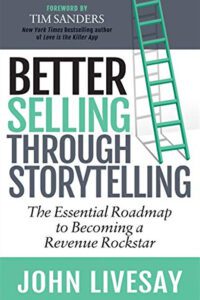
I listed all my characters. There’s a main character, and then they’re supporting characters that each need a name. You’re a very visual person. If you have your core character, your hero in the center, and then spikes like a bicycle coming off, “This is his sister.” The sister has a husband and a kid. That is not as core to Ben’s story, except for that one part, but then we need to have some sense of that relationship. His best friend is another, then his boss, and all these other things, and then a client that comes in.
I remember working with the editor, and I said, “I want this woman, who’s his boss, who gets the promotion that he doesn’t get to be more like, not so much Katie Couric and more like Diane Sawyer.” I started thinking of those because we know what that is. One’s got gravitas, one’s known for morning TV, lightness.
Having those subtle descriptions of these people’s personalities totally dictates what they’re going to say in the dialogue. Are they going to be chipper and happy, “Welcome everybody to the sales meeting?” That’s a Katie Couric version of that. Are they going to be more like Diane Sawyer, “Hello, everyone, let’s get to business?” What I imagine Diane Sawyer like at a meeting. Hopefully, that’s helpful for you.
Step one was figuring out the story, what you wanted to do, and the meaning of the story. Step two is listing your characters and then figuring out what you want the personality or this character is like someone you know, so you can stick them in that place. You’d know what kinds of things they might say, how they might handle stress, pressure, or whatever.
I recorded my book on Audible. That was an interesting challenge because there were multiple characters, and I had to subtly change my voice, so the listeners would know who was speaking. There’s an eight-year-old in there. That was a little challenging, but it was fun too.
How many characters are in your book?
There are about seven main characters and maybe another ten secondary characters.
How long did it take you to write the fable?
It was about a year process. I had the concept. For me, the challenge was who’s going to be the mentor that makes sense organically because every hero’s journey needs a mentor. There’s a book called The Energy Bus. That guy’s car broke down for two weeks, and the mentor in that was the bus driver. I needed to figure out what was going to happen or who it was going to be. I tried a different couple of ideas, and it’s not working. I had an ending that wasn’t working. I had to rethink that. It’s not like you go, “I got an idea.” As a sales keynote speaker, you keep refining it. When something gels together, it’s usually not your first effort.
[bctt tweet=”Be resilient and get back up after life knocks you down. ” username=”whyinstitute”]
That was good to know for the audience and for me because not working and rewrite is okay. It’s not going to come out of your pen onto paper perfect the first time. Not even close.
No. You need to keep digging deeper. “Is this a cliché thing? I don’t want to say anything to the cliché. I want to come up with something that’s ever been done before.” One of the things that are rewarding as an author and as a speaker is when you say something or write something that people start using right away. In this case, I realized that all of us, whether we’re in sales or not, and my premise is that everyone is in sales, will get rejected, frustrated, and disappointed. “How do we get out of that? Do we stay stuck in it?”
I created this thing called the 555 Method, where you zoom out like you’re the movie director of your own life, and you say, “Will this bother me in five minutes? Somebody cut me off in traffic. Will it bother me in five hours from now?” Hopefully, not. “How about five days from now? If I keep talking about it, then yes.” It’s our ability to be resilient and get back up after life knocks us down.
When something hard happened, like when my father died, I was so sad. I wish I’d had this tool because I thought, “If I could go and see five weeks, five months, or five years from now,” I’d say, “You’re going to still miss him, but you promise you will not be this sad five years from now.” I love hearing from people going, “Something happened, I 555 it, and I’d let it go much faster than I ever would have before. Thank you.” That’s why we do what we do.
Is the 555 is part of the fable?
Yes.
When is the John Livesay Fable Course coming out?
I’ve seen a course on storytelling that incorporates a lot of it already. As with anything, things keep evolving, and there are new tools and ideas. A lot of the current course involves some group coaching with me, where I add all the new things that I’ve learned from the fable into that.
When is the John Livesay How to Write a Fable Course coming out?

I don’t know that I’m an expert on that.
You’ve done it once because you’re way farther ahead than I am, and our readers would love to write a fable. Fables stick with you longer.
Yes, stories in general. It goes to different parts of our brain.
Is it a different part of the brain that has a better memory, or how does that work?
We remember things that have a great opening and a great closing. As a storytelling keynote speaker, you need to have that. That’s why movies live and die by a great opening and a great closing, and maybe something in the middle of the movie, but the majority of what you remember is a great opening that grabbed you, like the James Bond movies or this amazing closing where you didn’t think they were going to ever go together or you had me at hello or whatever that is.
That concept of a story being more memorable than a fact or a figure, it’s all about our brain going, “I felt something with that, and I’m tying that feeling to a memory,” as opposed to 30% faster. “Do I need to remember that? Is it going to save my life? Did I feel anything about that?” No, it’s like, “That’s nice to have. I’ll make more money or whatever.” It’s not nearly as memorable as a story that lands with you. If you see yourself in that story, then it’s immersed in your whole DNA.
You want to create a story that the majority of people will remember. Is that the thinking? Is it, “I want this story to hit the most amount of people, or do I want this story to connect with my ideal client?” What is the thinking that goes on when you decide which story to tell?
There are two things. I heard Elizabeth Gilbert interviewed about Eat, Pray, Love. She said, “I wrote that book for my best friend who could not go on the trip with me.” She had one person in mind, but because it was so universal in its appeal, hundreds of people could relate to that journey. When you tell a story, and you want to think of your brain, like a jukebox or a playlist, depending on your age, instead of songs coming out, different stories come out.
The ideal scenario is, “I have 5 to 10 stories in my head and if I’m talking to you as a former dentist, and I have a story about somebody else who used to be a dentist, and now as an entrepreneur, that’s the perfect story to tell you to you.” That’s what makes that customized. If you tell that story to someone that they see themselves in, and there are a lot of similarities, then they’re involved. We can’t have the same story to talk to everybody who’s a potential buyer. We need multiple stories for the different types of avatars that are out there.
[bctt tweet=”The whole goal of storytelling is to make it compelling enough that your readers don’t want to put it down. ” username=”whyinstitute”]
Do you have a list of stories that you know or tell? How many stories do you have?
I have about 40.
I’m trying to walk our readers through how they might go about becoming better storytellers. First, you got to have the story. You got to have your menu of stories.
You need a structure of what makes a good story, and then you’ve got one good one, and you’re like, “Now, I’ve got one that I know works, and why it works. I can duplicate that system.” I know you’re the master at scaling something once it’s proven. Once you understand the four steps to a great story, you go, “I’ve got one.” Don’t overwhelm yourself, and try to get 40. Just say, “I have three types of buyers that buy 80% of what I’m selling.”
I was working with a healthcare company in San Antonio. They offer dementia and assisted living for people with Alzheimer’s. They said, “We have three kinds of people that come to us. Somebody’s moving from out of state. Someone who has been living with an adult child and the adult child can’t take care of them anymore or someone who is at a different facility, and it wasn’t working out, and they need a new place.” Now, we know three different scenarios, and you can have three different stories ready to go that will cover you 80% of the time.
You almost have a plug-and-play type thing. “I know the scenario and story. Let’s go.”
You start telling the story. You remind me of another client. His name is Larry. They’re off and running.
Does every story have a memorable moment and saying? How do you create that?
The four parts of it are the exposition, who, what, where, when, so you paint the picture to pull them in, describing the problem in detail, the solution, and the secret is the resolution. Imagine if The Wizard of Oz stopped when Dorothy got in the balloon to go back to the end. No, there’s that scene where she’s at home. There’s no place like home. You were there and all this appreciation stuff. When you have a story that hits all four of those things, you know you’ve got a good structure going. The memorable parts come when you get sophisticated using Neuro-Linguistic Programming. If I say to you, “The car door slammed,” how do you experience that?

The last time, I felt somebody slam the car door.
Did you hear, feel, or see it?
I heard it.
From Neuro-Linguistic Programming, you’re an audio person. That means you say things like, “Does that ring a bell?” Your car’s sound system is probably upgraded. Things like that are important to you. Somebody else might be kinesthetic in feeling. They feel the car door slam. They talk about, “My gut doesn’t tell me this is the right thing to do.” They’ll say, “Does this feel like something you want to do?”
“Does that sound like the journey you’d like to go down?” That’s an auditory question. If you’re visual, like I am, you usually love photography. You say, “Do you see how the future could be together?” You speak in those terms. As a salesperson or communicator, it’s our job to try and hit all three. Other people can shift, but if you hit all three when you’re communicating, people don’t have to shift from their preference of how they experience the world.
Back to this, Alzheimer’s dementia situation. They said, “A patient came in, and she was so depressed. She had her head on the table.” I said, “That’s the beginning of a good story. Let’s amplify it.” We gave her a name and described it. “When Pat, who was 75, came to us six months ago, she was so depressed that we would hear a slight thud as her head hit the table. Imagine how depressed Pat had to feel to not even to want to look up and see what was going on around her.”
We’ve pulled all three of those sensations into a short little description of that person in the exposition. Now, we’re often running about what they did to help Pat feel better. That slight thud, as opposed to the visual of the head on the table, makes all the difference in the world of how you experience the story.
Let’s go back to your fable. What does the rhythm or graph look like in a fable? Is it an up and down five times or is it one up and down? What does that look like?
I was inspired by what’s known in the startup world as the trough of despair that’s mirrored in the hero’s journey. You get all excited, you’ve got this new idea for something, hit some obstacles, get depressed, and feel like, “No one else has ever been like this. What am I going to do? Am I going to reinvent myself? What’s going on?” You need some mentor or sherpa to come and get you out of that funk. It’s not a linear line out that you still have challenges and things, but you’re on your way up out of that trough of despair.
[bctt tweet=”Sometimes in storytelling, you start at the trough of despair instead of giving a lot of exposition upfront.” username=”whyinstitute”]
Sometimes people still get off the train at that place.
Sometimes in storytelling, you start at the trough of despair as opposed to giving a lot of exposition upfront. I tried to make mine like a James Bond movie where you’re in action right away. You’re like, “This poor guy. It’s going to be this horrible experience. He got a bad boss. He lost a sale. What’s going to happen to him?” As the story goes on and you start to hear more about his past and how he got there. That was a creative choice I made.
How many pages is the fable?
It’s three hours to listen to. It’s not long. I purposely made it like that. It is 160 pages.
You could read it in a day.
A couple of hours. That’s the whole goal. It’s compelling enough that you don’t want to put it down.
If people are reading and they’re saying, “I need to get ahold of John. I want to work with him. I want to learn to tell a better story. I want to sell the stories. I want to be a better storyteller. I want to get a fable. I got to connect with them,” what’s the best way for people to connect with you?
Go to my website, JohnLivesay.com. If you can’t remember my name or the book name, google The Pitch Whisperer, and all my content show up. I have a free gift for everybody, which is if you text the word PITCH to 66866. You enter your email in. I’ll send you a free chapter of the book, and that should be enough to entice you to want to read what happens next.
John, thank you so much for being here again. We got even deeper than we did last time. I’m glad we got to learn more about the fable and dive back into storytelling because I learned a ton that I don’t think we went through last time. Thank you for sharing all that.
My pleasure, Gary. It’s great being back. Thanks for having me.
I can’t wait to follow you.
Important Links
- The Sale Is in the Tale
- Be The Lifeguard of Your Own Life! – TEDx Talk
- The Successful Pitch Podcast
- Who Moved My Cheese?
- The Go Giver
- Getting Naked
- Better Selling Through Storytelling
- The Energy Bus
- Eat, Pray, Love
- JohnLivesay.com
- Revenue Rockstar Mastery
About John Livesay
 John Livesay, aka The Pitch Whisperer, is a sales keynote speaker where he shows companies’ sales teams how to turn mundane case studies into compelling case stories so they win more new business. From John’s award-winning career at Conde Nast, he shares the lessons he learned that turns sales teams into revenue rock stars. His TEDx talk: Be The Lifeguard of Your Own Life has over 1,000,000 views.
John Livesay, aka The Pitch Whisperer, is a sales keynote speaker where he shows companies’ sales teams how to turn mundane case studies into compelling case stories so they win more new business. From John’s award-winning career at Conde Nast, he shares the lessons he learned that turns sales teams into revenue rock stars. His TEDx talk: Be The Lifeguard of Your Own Life has over 1,000,000 views.
Clients love working with John because of his ongoing support after his talk which includes implementing the storytelling skills from his best-selling book Better Selling Through Storytelling and online course “Revenue Rockstar Mastery.”
His new book, The Sale Is in the Tale, is a business fable set in Austin, TX, is about a sales representative whose old ways of selling are not working anymore. The reader accompanies the rep on his journey and learns how to use storytelling and strengthen their soft skills to improve their professional and personal relationships.
He is also the host of “The Successful Pitch” podcast, which is heard in over 60 countries. These interviews make him a sales keynote speaker with fresh and relevant content.
